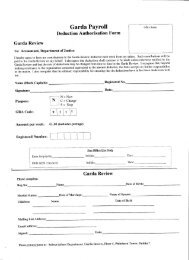Conference Report 2016
Table of contents contains links on page 5. It can be used to skip through chapters.
Table of contents contains links on page 5. It can be used to skip through chapters.
Create successful ePaper yourself
Turn your PDF publications into a flip-book with our unique Google optimized e-Paper software.
Section 1: Pay and Allowances<br />
5.10 Having regard to this reality the Association<br />
proposes that this Review enables an appropriate<br />
uprating of Garda pay in the form of an allowance in<br />
recognition of the many unique features associated<br />
with the job of policing. There is already a pertinent<br />
precedent for such an allowance (in the Defence<br />
Forces) and this Association believes that a Police<br />
Service Allowance would serve to compensate<br />
Garda personnel for the special disadvantages<br />
associated with police life.<br />
5.11 However, despite this ‘unique’ status, there is some<br />
substance to the conclusion of the 1979 Ryan<br />
Committee of Inquiry, which contended that:<br />
“The pay of members of the Force cannot be totally<br />
divorced from increases in pay achieved in outside<br />
employment generally.”<br />
5.12 The Sheehy <strong>Report</strong> (in Britain) reiterated this view:<br />
“…it is difficult to establish market comparisons<br />
across the whole range of duties at police constable<br />
level. Subject to various special factors…we<br />
nonetheless believe it is possible to establish broad<br />
market comparisons in respect of basic pay.”<br />
5.13 Eventually this Inquiry opted for a police pay<br />
benchmark set at the median of private sector pay,<br />
subject to the acknowledgment of ‘policing as a<br />
profession’. Consequently the Inquiry deemed it<br />
inappropriate to compare police officers to manual<br />
workers for pay or any other purpose; thus resorting<br />
to a link with the median of the ‘white collar’ private<br />
sector pay distribution. The British Government<br />
subsequently accepted this (non-manual) private<br />
sector pay benchmark as constituting the formula<br />
for the annual uprating of police pay. In the view of<br />
the then British Home Secretary:<br />
“This linkage recognises both the professionalism<br />
of the police service and its special nature, which<br />
justifies the comparison with settlements in the<br />
private sector.”<br />
5.14 The Department of Justice has recognised the<br />
‘unique’ character of the Garda’s job, accepting that<br />
‘there is no strictly comparable group’, thus<br />
necessitating an examination of ‘a wide range of<br />
employments’ to facilitate the pay determination<br />
process.<br />
5.15 The Association accepts that such is the nature of<br />
the industrial relations process and employees’<br />
perceptions to the equity of their pay level. In<br />
addition to compensation for the ‘unique’ status<br />
associated with the rank’s role, account should also<br />
be taken of the garda’s relative pay compared with<br />
employees in general, with other public service<br />
employees and internal relativities.<br />
Impoverished Gardaí – the bottom line<br />
5.16 A sizeable proportion of gardaí are in the 30 to 45<br />
age bracket when financial obligations are<br />
especially onerous. The General Secretary of this<br />
Association has clarified Garda ‘income’ matters for<br />
the benefit of the Public Accounts Committee:<br />
“It is also important to say that there is a great deal<br />
of frustration among young gardaí, particularly<br />
those with about eight or nine years’ service, who<br />
hear again through the media that the average pay<br />
they receive is in the region of €53,000.<br />
“I have a payslip here that reflects the pay of about<br />
80% of the members I represent and it can be sent<br />
to the Chairman, if that is what he requires. The pay<br />
of a member of the Garda Síochána – it can be<br />
clearly shown – is €46,631 for a member with nine<br />
years’ service – it is not €53,480. They get very<br />
annoyed and aggrieved when this kind of wage<br />
average is put out in the public arena.”<br />
5.17 Whilst some of the desperation and disillusionment<br />
currently associated with working as a garda may<br />
be attributed to the recent recession and<br />
associated cutbacks, it should not be forgotten that<br />
gardaí were poorly served under the first Public<br />
Sector Benchmarking Body’s report. As a<br />
consequence, gardaí secured a 5% award in<br />
comparison with an overall average increase of 9%.<br />
Given the longstanding and wide scale focus on<br />
internal relativities, this award was aggravated by<br />
the fact that garda sergeants (6%), inspectors (6%),<br />
superintendents (16%) and chief superintendents<br />
(16.1%) received superior awards.<br />
5.18 The basic pay scale for members of Garda rank<br />
spans from €23,171 to €46,000 per annum. It is<br />
appropriate to acknowledge that such payments<br />
tend to accrue from onerous duties, after working<br />
nights, working weekends and working compulsory<br />
overtime; duties undertaken in all kinds of inclement<br />
weather conditions, with the real and increasing risk<br />
of being assaulted or abused and enduring lifelong<br />
or life-threatening physical or psychological injury.<br />
The enduring case for supplementary payments for<br />
the rank are further addressed.<br />
38th Annual Delegate <strong>Conference</strong><br />
33




